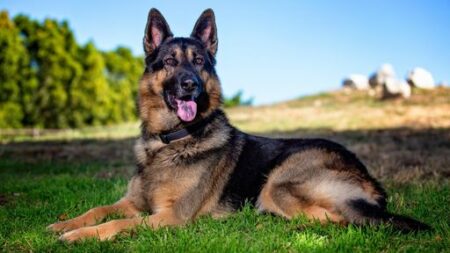Have you ever wondered why do dogs have slits in their ears? We all know that they are cute, but why does this happen to them? Have you considered why some breeds of dogs like the Shih Tzu, Pekingese, and Lhasa Apso have more slit-shaped ears than others?
The ear anatomy of dogs and cats can be so interesting. I bet you never knew that a dog’s paws often smell like popcorn or why some are born without an ear! You might also think your pet has oddities if they scratch at one spot in their ears all the time, but there is actually something called “ear-scratching,” – which prompts these behaviors for certain breeds as well.
They’re called “cutaneous marginal pouches,” or Henry’s pockets for a reason. Dog owners may wonder what their pup is up to when they see this curious feature on his body. Let’s look at 10 surprising reasons why dogs have slits in their ears.
Why Do Dogs Have Slits In Their Ears
For Better Hearing
It is also known as Henry’s pocket or, in scientific speak, a cutaneous marginal pouch. Serves as a barrier or corral for sound waves as they enter the ear canal. The slits help direct sound waves into the ear and amplify them. This is why dogs with long hair in their ears often have hearing problems. The hair can obstruct the sound waves entering and traveling down the ear canal.
Dogs are domestic animals that have a sense of hearing that is 10 times stronger than humans, and they use their ear slits to help them hear better.
And the reason why dogs have ear slits is that they are descendants of wolves. Wolves, and therefore dogs, evolved these ear slits to help them hear the high-pitched sounds that their prey makes.
Dog breeds with droopy ears, like Basset Hounds or Bloodhounds, Boston terriers actually have more sensitive hearing than other dog breeds because they need to be able to pinpoint where sound is coming from.
Dogs have ears that are very different from human ears; there is one big difference in particular. Dogs have ear slits that allow them to hear in a very different way from humans, and the ear slits are yet another reason why dogs have such an amazing sense of hearing.
Different animals have very different ears, not just dogs. Cats, for example, have small holes in their ear that are called “tremas.” These tremas are different from ear slits, but they have the same function as dog ears that hear sounds in a very different way.

Helps In Picking Up On High Pitched Sounds
The shape of the ear canal helps funnel sound waves into the inner ear, making it easier to pick up on high-pitched sounds like bird chirps and other small noises we can’t hear as well as dogs can.
Some people think that dogs have ear pocket because when they were domesticated, their owners started to crop their ears so that the dogs couldn’t scratch them.
This is not true, though, as dogs had their ear slits for millions of years before they were domesticated. In fact, the first dogs were bred from wolves, and wolves have always had ear slits.
Help In Keeping The Water Out
Slits or fold of skin in dogs’ ears allow them to hear better and help keep water out when swimming or running through puddles.
The slits allow for air to go through them when the dog is swimming or running, preventing the water from going into their ear canals and damaging their hearing.
When the dog shakes its head or pulls back on its leash, water and dirt can get into the ear canal and cause infections and other problems. The slits help to prevent this from happening.
Good Climate Control
Dogs have ear slits because they help to regulate their body temperature. Dogs can’t sweat, so the slits allow them to release heat from their ears, which cools their body.
Earflaps are thought to help cool dogs off by lowering their body temperature, which can be very useful in warm weather. This is especially important for breeds with long hair around their ears, as this can trap heat and make them more prone to overheating.
Reduce Wind Resistance
The shape of a dog’s ear flap is designed to reduce wind resistance while hunting or running at high speeds.
This is especially important for dogs that have long ears. Accordion pocket in the ear help minimize wind resistance and allow a dog’s ears to move around more freely.
This is why dogs with long hair in their ears often have hearing problems. The hair can obstruct the sound waves entering and traveling down the ear canal.
Better Appearance
Some breeds are predisposed to having slit ears because it gives them a more desirable appearance for show purposes. Dogs that have ears with a noticeable fold in them are not allowed to be shown at competitions.
They will often have their ears taped so they stand up, and the judges can get a better look at them.
Less Debris
Many breeds have long floppy ears that do not allow air to pass through them as much as those with ear flaps. This means that these dogs are more likely to get debris caught in their ear, leading to infection.
Dogs with slits are less likely to have this problem because the flaps allow air and other things through them somewhat easily, so they do not create a suitable environment for bacteria or dirt.
Preventing Infections
Dogs that have floppy ears often get infections in their ears because the hair traps moisture and creates a perfect breeding ground for bacteria.
Earflaps help prevent this by allowing air to circulate more freely and preventing moisture from building up. This is especially important for breeds prone to getting fungal infections, middle ear infections, such as Cocker Spaniels.
Protection From The Sun
Dogs with long ears are susceptible to the sun. The dark, floppy parts of their ear can get hot quickly because they do not allow much air circulation around them.
This means that hot spots or burns could occur on their skin without owners even knowing it until severe damage is done.
Slits in dogs ears give them protection from the sun by allowing air to pass through them and circulate around the skin.
This prevents hot spots from forming on their ears, which can be very painful for dogs because they contain nerve endings that give them a heightened sense of pain.
Preventing Injuries
Dogs with floppy organ of hearing are more susceptible to ear infections and other issues in their ears due to water building up inside of them when it rains or snows.
Slits allow moisture and dirt out but will still keep enough moistness in there so that bacteria cannot grow rapidly while also protecting dogs from extreme weather conditions such as heavy rain or snowfall.
They help prevent these problems by providing an outlet for moisture to escape before causing any damage within the ear canal itself. In this way, they can help prevent long-term damage to a dog’s hearing.
There are many reasons why dogs have a skin fold in their ears, and each one of them is important in its own way.
These flaps serve as protection for the ear canal and help keep the inside of the ear clean and dry by allowing air to circulate more freely.
They also protect dogs from sunburns, injuries, and other problems that can occur when they have long floppy ears.
Slits in a dog’s ears are an essential part of their anatomy and should not be overlooked when considering why they are the way they are.
Pet owners should consider all of the benefits that these flaps provide to better understand why dogs have ear flaps and the important role they play in their day-to-day lives.
Conclusion
The answer is not as simple as you might think. Dogs have slit ears for many reasons, including helping them hear better and keeping their ear canals clean.
Some dogs even need this type of cut to keep from ripping the skin off their head during rough play or exercise! We’ve got more on what those slits mean in our blog post about dog health issues that we hope will be helpful.
If you still have questions, ask us in the comments! I hope this article helped explain why do dogs have slits in their ears.
Thanks for reading!
Why do dogs have cuts on their ears?
Dogs have cuts on their ears for many reasons. An ear cut is usually the result of an injury that has occurred to the dog’s ear. Blemishes on a dog’s ear can be caused by several things, including blunt force trauma, cuts from other animals, insect bites, and contact with a sharp object.
If you notice that your dog has a cut on his or her ear, it is crucial to take the proper steps to ensure that the injury heals properly.
Cuts on a dog’s ear should be cleaned and treated with antibiotics if necessary. If the cut is severe, it may require stitches. In most cases, the cut will heal on its own.
Cuts are common in dogs, so it is important to remain attentive to your dog’s ears at all times. If you notice a problem with one or both of your dog’s ear butts, consult with your veterinarian for more information and assistance.
What is a Henry’s pocket on dogs?
Henry’s pocket is a small, fleshy protrusion that can be found on the inside of a dog’s ear. This structure is named after its discoverer, Dr. Henry H. Goddard.
The purpose of this pocket is unknown, but it is thought to play some role in the canine auditory system. Some experts believe that the pocket may help amplify sound, while others believe it helps direct sound into the ear canal.
Henry’s pocket is a relatively common structure, and it is generally considered to be benign. However, if you notice any changes in the size or appearance of this pocket, you should consult your veterinarian for more information and assistance.
What is the extra flap on dog’s ears?
The extra flap on a dog’s ear is known as the pinna. This structure is made up of cartilage and skin, and it contains blood vessels, nerve endings, and sweat glands.
A dog’s pinna is covered by a layer of hair that protects it from the environment.
The purpose of the pinna is to collect sounds and direct them into a dog’s ear canal. The shape and size of a dog’s pinna can vary from breed to breed, and some breeds have larger pinnae than others.
Do all dogs have Henry’s pocket?
No, not all dogs have a Henry’s pocket. This structure is found in only some breeds of dogs.
The presence of this pocket can vary from dog to dog, and it is not always present in every animal. If your dog does have a Henry’s pocket, there is usually no need for concern.
Do dogs have belly buttons?
No, dogs do not have belly buttons. This is because a dog’s umbilical cord is usually cut and removed after birth. Without a functioning umbilical cord, there is no way for the navel to form.
Do dogs sweat?
Yes, dogs sweat. Dogs use their sweat glands to cool down their bodies when they get too hot. Dogs have two types of sweat glands: eccrine and apocrine.
Eccrine sweat glands are found all over a dog’s body. In contrast, apocrine sweat glands are located primarily in the armpits and groin.
Sweat from eccrine glands is clear and odorless, while sweat from apocrine glands is thick and has a strong odor. Dogs will usually pant or lick their lips to cool down when they are hot.
Do all dogs have ears?
No, not all dogs have ears. Some breeds of dogs, such as the bulldog, are born without external ears. These animals rely on their owners to clean and care for their ear canals. Other breeds, such as the beagle, have floppy ears that can easily become infected if not cleaned and treated regularly.
Why do dogs have wet noses?
Dogs have wet noses because they have a unique structure called the “vomeronasal organ.” This extra nose-like opening connects to the dog’s nasal cavity.
The vomeronasal organ allows dogs to sense smells, and it also helps them identify pheromones from other animals.
Why do dogs have whiskers?
Dogs have whiskers because they need them to sense their environment. Whiskers are extremely sensitive, and they can help dogs identify obstacles, track prey, and navigate in the dark.
Dogs use their whiskers to feel around their surroundings, and they will often move their whiskers from side to side when trying to scent something.
Do all dogs like to be petted?
No, not all dogs like to be petted. Some dogs enjoy being petted, while others do not. It is important to ask your dog if they want to be petted before you start stroking them. If your dog does not seem to enjoy being petted, you should stop and try again later.
What is a dog’s tail for?
A dog’s tail is primarily used for communication. Dogs use their tails to express emotions such as happiness, fear, aggression, and love. They will also wag their tails when they are excited or happy.
Tail position can also be used to communicate information to other dogs. For example, a dog holding its tail high and wagging it rapidly is likely to be aggressive. In contrast, a dog with its tail low is still likely to be scared or submissive.
Welcome to my blog, where I share my love for all things canine! As an older lady who has spent a lifetime surrounded by dogs, I feel it’s important to share my experiences and the joy that these furry companions bring into our lives. From my first dog, a spunky little mutt, to the loyal and loving dogs who have been by my side throughout the years, each one has left an paw print on my heart. Through my blog, I hope to inspire others to appreciate the love, loyalty, and companionship that dogs bring. So come along on this journey with me as we celebrate the wonderful world of dogs!





